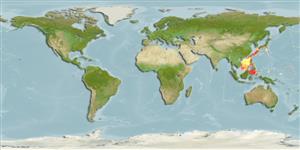Common names from other countries
Пластиножаберные (акулы и скаты) (sharks and rays) >
Carcharhiniformes (Ground sharks) >
Pentanchidae (Deepwater catsharks)
Etymology: Apristurus: a-, Latin privative, i.e., without; pristis, from pristes (Gr.), sawyer (but here meaning saw); oura (Gr.), tail, referring to absence of saw-toothed crest of enlarged dermal denticles along upper edge of caudal fin as found in the closely related Pristiurus (=Galeus). (See ETYFish); platyrhynchus: platys (Gr.), wide; rhynchus (L.), snout, referring to its shorter, wider snout compared with A. macrorhynchus. (See ETYFish).
More on author: Tanaka.
Environment: milieu / climate zone / depth range / distribution range
экология
морской батипелагический; пределы глубины 759 - ? m (Ref. 58018). Deep-water; 35°N - 1°N
Western Pacific: Philippines, South and East China seas; northward to the Suruga Bay, Japan.
Size / Вес / Возраст
Maturity: Lm ? range ? - ? cm
Max length : 80.0 cm TL самец/пол неопределен; (Ref. 244); 63.0 cm TL (female)
колючие лучи спинного плавника (общее число) : 0; колючие лучи анального плавника: 0. Diagnostic features include the very short abdomen, with interspace between pectoral and pelvic fins base shorter than 3/5 of anal fin base length; pectoral fin tip reaching beyond the midpoint between pectoral and pelvic fins; first dorsal fin smaller in area than the second dorsal; posterior end base (axil) of second dorsal clearly in front of anal fin axil; low anal fin with a long base. Egg capsule very slender; without tendrils, conical posterior end. Claspers without hooks, with posterior margin of exorhipidion forming a free lobe (Ref. 37959). Black, brown or grey (Ref. 11146), without conspicuous markings on fins (Ref. 244).
Found on the continental slopes. Poorly known. Oviparous, probably one egg per oviduct laid at a time. Not utilized at present.
Life cycle and mating behavior
Maturities | размножение | Spawnings | Egg(s) | Fecundities | личинки
Oviparous, paired eggs are laid. Embryos feed solely on yolk (Ref. 50449).
Compagno, L.J.V., 1984. FAO Species Catalogue. Vol. 4. Sharks of the world. An annotated and illustrated catalogue of shark species known to date. Part 2 - Carcharhiniformes. FAO Fish. Synop. 125(4/2):251-655. Rome: FAO. (Ref. 244)
Статус Красного Списка МСОП (Ref. 130435)
CITES (Ref. 128078)
Not Evaluated
Угроза для людей
Harmless
Использование человеком
рыболовство: интереса не представляет
дополнительная информация
инструменты
Специальные отчеты
Скачать в формате XML
ресурсы в Интернет
Estimates based on models
Preferred temperature (Ref.
115969): 3 - 10.1, mean 3.4 (based on 121 cells).
Phylogenetic diversity index (Ref.
82804): PD
50 = 0.5000 [Uniqueness, from 0.5 = low to 2.0 = high].
Bayesian length-weight: a=0.00355 (0.00176 - 0.00714), b=3.09 (2.91 - 3.27), in cm Total Length, based on LWR estimates for this (Sub)family-body shape (Ref.
93245).
Trophic level (Ref.
69278): 4.0 ±0.4 se; based on size and trophs of closest relatives
устойчивость к внешним воздействиям (Ref.
120179): очень низкий, минимальное время удвоения популяции более 14 лет (Fec assumed to be <10).
Fishing Vulnerability (Ref.
59153): Moderate to high vulnerability (52 of 100).
